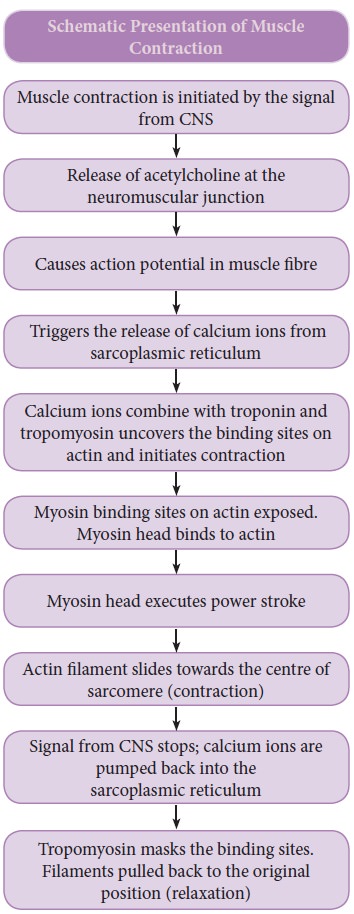Chapter: 11th Zoology : Chapter 9 : Locomotion and Movement
Mechanism of muscle contraction
Mechanism of muscle contraction
Sliding filament theory in 1954, Andrew F. Huxley
and Rolf Niedergerke proposed the sliding-filament theory to explain muscle
contraction. According to this theory, overlapping actin and myosin filaments
of fixed length slide past one another in an energy requiring process,
resulting in muscle contraction. The contraction of muscle fibre is a
remarkable process that helps in creating a force to move or to resist a load.
The force which is created by the contracting muscle is called muscle tension.
The load is a weight or force that opposes contraction of a muscle. Contraction
is the creation of tension in the muscle which is an active process and
relaxation is the release of tension created by contraction.

Muscle contraction is initiated by a nerve impulse sents by the central nervous system (CNS) through a motor
neuron. The junction between the motor neuron and the sarcolemma of the muscle
fibre is called the neuromuscular junction or motor end plate. When nerve
impulse reaches a neuromuscular junction, acetylcholine is released. It
initiates the opening of multiple gated channels in sarcolemma. The action
potential travels along the T-tubules and triggers the release of calcium ions
from the sarcoplasmic reticulum. The released calcium ions bind to troponin on
thin filaments. The tropomyosin uncovers the myosin-binding sites on thin
filaments. Now the active sites are exposed to the heads of myosin to form a
cross-bridge. During cross- bridge formation actin and myosin form a protein
complex called actomyosin. Utilizing the energy released from hydrolysis of
ATP, the myosin head rotates until it forms a 90° angle
with the long axis of the filament. In this position myosin binds to an actin
and activates a contraction – relaxation cycle which is followed by a power
stroke.
The power stroke (cross-bridge tilting) begins
after the myosin head and hinge region tilt from a 90° angle to a 45° angle. The cross-bridge
transforms into strong, high-force bond which allows the myosin head to swivel.
When the myosin head swivels it pulls the attached actin filament towards the
centre of the A-band. The myosin returns back to its relaxed state and releases
ADP and phosphate ion. A new ATP molecule then binds to the head of the myosin
and the cross-bridge is broken. At the end of each power stroke, each myosin
head detaches from actin, then swivels back and binds to a new actin molecule
to start another contraction cycle. This movement is similar to the motion of
an oar on a boat. At the end of each power stroke, each myosin head detaches
from actin, then swivels back and binds to a new actin molecule to start
another contraction cycle. The power stroke repeats many times until a muscle
fibre contracts. The myosin heads bind, push and release actin molecules over
and over as the thin filaments move toward the centre of the sarcomere. The
repeatedly formation of

The Z- discs attached to the actin filaments are also pulled
inwards from both the sides, causing the shortening of the sarcomere (i.e.
contraction). This process continues as long as the muscle receives the stimuli
and a steady flow of calcium ions. When motor impulse stops, the calcium ions
are pumped back into the sarcoplasmic reticulum, results in the masking of the
active sites of the actin filaments.The myosin head fails to bind with the
active sites of actin and these changes cause the return of Z- discs back to
their original position, i.e. relaxation.

Related Topics